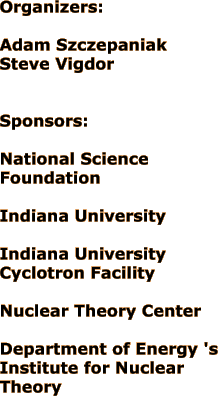





18th National Nuclear Physics Summer School
July 23 - August 5, 2006
Indiana University, Bloomington, IN
 |
 |
 |
 |
 |
|||
 |
18th National Nuclear Physics Summer School July 23 - August 5, 2006 Indiana University, Bloomington, IN |
||||||
 |
|||||||||
Nuclear Physics Summer School Proposal Project Summary The proposal requests funds to continue the National Summer School in Nuclear Physics, held annually since 1988, for an additional five years. The school would bring together leading researchers to lecture on their specialties to advanced graduate students in experimental and theoretical nuclear physics. The overall goal of the schools is to provide students with a reference frame for defining critical problems of nuclear physics and the most useful methods of analysis of the problems. The intent is to broaden the students's appreciation for and interest in our field while also strengthening them technically. In bringing students together from different parts of nuclear physics, the school also plays an important role in building a nuclear physics community: the school often is the first opportunity for young researchers to interact across subfields. The school is governed by a national steering committee, appointed by the Executive Committee of the Division of Nuclear Physics, APS. The PIs will work with the steering committee and with school organizers to facilitate the annual schools. Proposed Project 1. Introduction Some changes in the school's governance are proposed: 1) We ask that funding be sufficient to allow smaller university groups to organize schools: previously the requirement that the host institution cover all lecturer costs made this difficult. 2) In spring, 1999, the Division of Nuclear Physics of the APS agreed to make the school's steering committee one of its standing committees. This step will help the steering committee remain broadly representative of the community. The PIs will administer the grant through the Institute for Nuclear Theory (INT). The INT remains willing to help organizers with school administration, as desired. This includes producing a poster, handling mailing, and maintaining data bases. 2. Motivation and History Under these conditions students can go through graduate training and postdoctoral experience without developing clear ideas of the important outstanding questions in nuclear physics outside of their specialty. Yet there are broad physics themes and important techniques that do unite our field: a student with too limited a perspective is unlikely to understand this unity or to maximize his personal scientific development. The experimental physicist must know what properties of nuclear and hadronic/electromagnetic/weak interactions are most significant to measure in order to further knowledge in nuclear physics or in other fields that require nuclear physics input. The theoretical student must appreciate better the important criteria for useful models, the significance of reported measurements, and the relevance of nuclear physics to sister fields, such as particle physics, astrophysics, and condensed matter physics. In Europe, the summer school has proven to be a very successful way to broaden the perspective of students. There are regular schools at Varenna, Italy; at Erice, Italy; and many NATO sponsored schools, including the one at Les Houches, France. The UK Nuclear Physics Summer School and the Nordic Nuclear Physics Summer School are held regularly, and the Finish Summer School often has a strong nuclear component. The Euro Summer School on Exotic Beams is held in Leuven. In Eastern Europe, there are regular schools in Poland, Hungary and the Czech Republic. Elsewhere, the Brazilian Andre Swieca Physics Summer School is primarily focused on nuclear physics, while the ANU Australian Summer School often has a strong nuclear component. In this country the NSF has sponsored regular advanced schools in the 1960's, an ad hoc nuclear physics school in 1978 and 1981, and several series since 1983. In particular, in 1988, a community group - which included the PIs of this proposal and some members of the current steering committee - began the current series. Initially it was supported year-by-year with volunteer organizers, who had little administrative support. The difficulty of this mode of operation contributed to the failure of the 1994 effort. It was then that the steering committee, with a strong endorsement from the Executive Committee of the Division of Nuclear Physics, opened discussions with the NSF and INT to provide more stability to the school. The NSF agreed to provide a 5-year grant to support participant costs at the school. The INT agreed to administer the grant at no cost and to provide administrative support to school organizers: poster production, mailing, data base services, etc. The INT also agreed to act as a back-up host for the school, if no other volunteer could be found, and to provide supplementary funding to any schools held in the Seattle area (provided by the UW Physics Department's Uehling Fund). The INT hosted the 1995 and 1996 schools and is renewing the above commitments for the lifetime of the present proposal. In recent years there have been ad hoc schools in nuclear physics organized by CEBAF (annually) and by Brookhaven (1998). (No BNL school is scheduled for 1999.) These schools are sponsored by the host laboratories and focus on research issues relevant to those laboratories. There has also been an annual school at TRIUMF, but it was discontinued in 1999. 3. Requirements of the school 3.1 Location |
|||||||||
 |
|||||||||